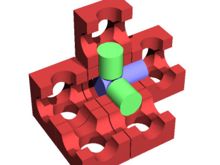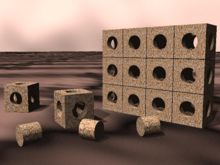Difference between revisions of "Universal bricks"
| Line 6: | Line 6: | ||
==Six hole cube== | ==Six hole cube== | ||
[[Image:UniversalBricks00.jpg|thumb|left|120px|six-hole-cube with pin]] | [[Image:UniversalBricks00.jpg|thumb|left|120px|six-hole-cube with pin]] | ||
| + | [[Image:UniversalBricks01.jpg|thumb|right|220px|sectional view of the connection principle with two short pins (green) and one long pin (blue) per brick ]] | ||
The '''six-hole-cube''' allows the construction of three dimensional objects, e.g. [[building]]s. The object can be extended in all three dimensions by putting additional bricks in place and connect them with the cylindric pins to the other bricks. The pins are manufactured to fit into the holes of the brick firmly. A certain force is required to insert the pins. | The '''six-hole-cube''' allows the construction of three dimensional objects, e.g. [[building]]s. The object can be extended in all three dimensions by putting additional bricks in place and connect them with the cylindric pins to the other bricks. The pins are manufactured to fit into the holes of the brick firmly. A certain force is required to insert the pins. | ||
The connection between the bricks is held only by the cylindric pins (from the same material). Three pins for each brick are used to extend the construction in all three dimensions two pins with half the length of the brick and one pin with the length of the brick. | The connection between the bricks is held only by the cylindric pins (from the same material). Three pins for each brick are used to extend the construction in all three dimensions two pins with half the length of the brick and one pin with the length of the brick. | ||
| + | |||
| + | [[Image:UniversalBricks02.jpg|thumb|right|220px|building a wall from six-hole-cubes on Mars]] | ||
After putting the brick in place the two short pins are inserted through the center of the brick, eventually leaving the center free. Then the long pin is inserted, making the third connection, filling the center and thus securing the two short pins. | After putting the brick in place the two short pins are inserted through the center of the brick, eventually leaving the center free. Then the long pin is inserted, making the third connection, filling the center and thus securing the two short pins. | ||
| + | Editing Universal bricks - Preview - Marspedia | ||
| + | The wall under construction poses holes in regular intervals, which can be used as a foothold for an automatic construction machine. A whole building can be built this way automatically with a planned position for each brick. | ||
| − | The | + | ===Open issues=== |
| + | *How can a rift or gap in the wall be closed? | ||
| + | |||
| + | |||
| + | ==Ten hole cube== | ||
| + | [[Image:UniversalBricks03.jpg|thumb|right|120px|ten-hole-cube with pin]] | ||
| + | The ten-hole-cube provides better stability, because it can be used for overlapping bond. | ||
| − | + | ==Elasticity== | |
| − | + | Sintered regolith is not elastic. Additional means to introduce elasticity to the wall is necessary to avoid destabilization by compression settlement of the underground, temperature tension, etc. | |
| − | + | * Coating of brick and pin with a layer of [[synthetic materials|elastic material]] | |
| − | * | + | * Zoning of the building with sliding layers in between |
| − | * | ||
[[Category: Concepts]] | [[Category: Concepts]] | ||
Revision as of 12:39, 28 October 2008
Universal brinks for building construction on Earth are usually made from clay, and the masonry is build from bricks and grout. Many identical bricks can be arranged to any big structure. Even domes can be made. On Mars it might not be possible to produce grout. This article wants to collect ideas how to make universal bricks that do not need grout.
Material
The brick can be made from sintered regolith, plastics, or fiberglass.
Six hole cube
The six-hole-cube allows the construction of three dimensional objects, e.g. buildings. The object can be extended in all three dimensions by putting additional bricks in place and connect them with the cylindric pins to the other bricks. The pins are manufactured to fit into the holes of the brick firmly. A certain force is required to insert the pins.
The connection between the bricks is held only by the cylindric pins (from the same material). Three pins for each brick are used to extend the construction in all three dimensions two pins with half the length of the brick and one pin with the length of the brick.
After putting the brick in place the two short pins are inserted through the center of the brick, eventually leaving the center free. Then the long pin is inserted, making the third connection, filling the center and thus securing the two short pins. Editing Universal bricks - Preview - Marspedia The wall under construction poses holes in regular intervals, which can be used as a foothold for an automatic construction machine. A whole building can be built this way automatically with a planned position for each brick.
Open issues
- How can a rift or gap in the wall be closed?
Ten hole cube
The ten-hole-cube provides better stability, because it can be used for overlapping bond.
Elasticity
Sintered regolith is not elastic. Additional means to introduce elasticity to the wall is necessary to avoid destabilization by compression settlement of the underground, temperature tension, etc.
- Coating of brick and pin with a layer of elastic material
- Zoning of the building with sliding layers in between










